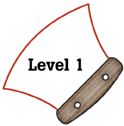|
National Science Education Standards
Employ simple equipment and tools to gather data and extend the senses.
In early years, students develop simple skills, such as how to observe,
measure, cut, connect, switch, turn on and off, pour, hold, tie, and hook.
Beginning with simple instruments, students can use rulers to measure
the length, height, and depth of objects and materials; thermometers to
measure temperature; watches to measure time; beam balances and spring
scales to measure weight and force; magnifiers to observe objects and
organisms; and microscopes to observe the finer details of plants, animals,
rocks, and other materials. Children also develop skills in the use of
computers and calculators for conducting investigations. (Page 122)
Use data to construct a reasonable explanation. This aspect of the standard
emphasizes the students’ thinking as they use data to formulate explanations.
Even at the earliest grade levels, students should learn what constitutes
evidence and judge the merits or strength of the data and information
that will be used to make explanations. After students propose an explanation,
they will appeal to the knowledge and evidence they obtained to support
their explanations. Students should check their explanations against scientific
knowledge, experiences, and observations of others. (Page 122)
Communicate investigations and explanations. Students should begin developing
the abilities to communicate, critique, and analyze their work and the
work of other students. This communication might be spoken or drawn as
well as written. (Page 122)
Simple instruments such as magnifiers, thermometers, and rulers provide
more information than scientists obtain using only their senses. (Page
123)
Scientists develop explanations using observations (evidence) and what
they already know about the world (scientific knowledge). Good explanations
are based on evidence from investigations. (Page 123)
|
|
Benchmarks
People can often learn about things around them by just observing those
things carefully, but sometimes they can learn more by doing something
to the things and noting what happens. (Page 10)
Tools such as thermometers, magnifiers, rulers, or balances often give
more information about things than can be obtained just by observing things
without their help. (Page 10)
Describing things as accurately as possible is important in science
because it enables people to compare their observations with those of
others. (Page 10)
Ask “How do you know?” in appropriate situations and attempt
reasonable answers when others ask them the same question. (Page 298)
|


